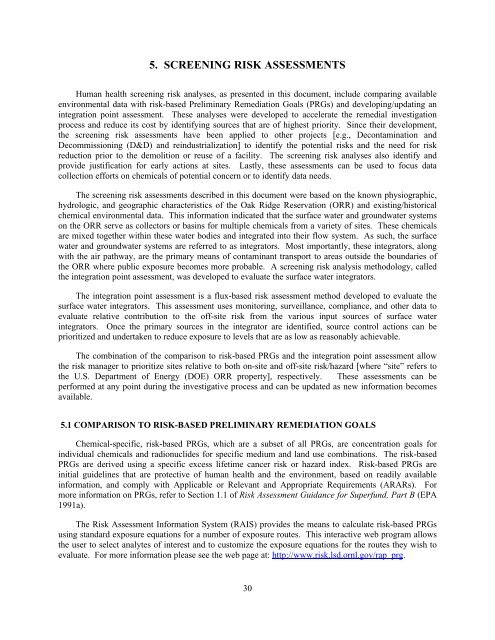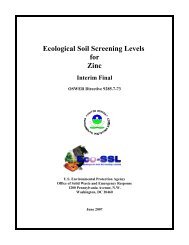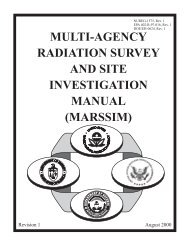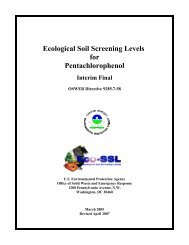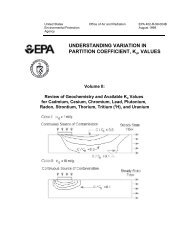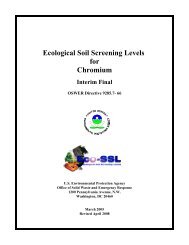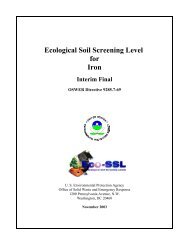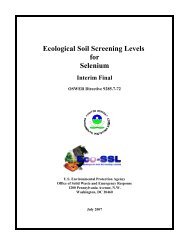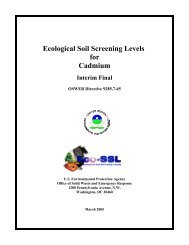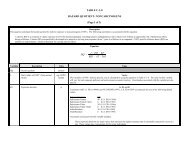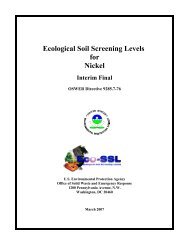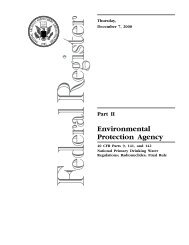Guidance for Conducting Risk Assessments and Related Risk ...
Guidance for Conducting Risk Assessments and Related Risk ...
Guidance for Conducting Risk Assessments and Related Risk ...
You also want an ePaper? Increase the reach of your titles
YUMPU automatically turns print PDFs into web optimized ePapers that Google loves.
5. SCREENING RISK ASSESSMENTS<br />
Human health screening risk analyses, as presented in this document, include comparing available<br />
environmental data with risk-based Preliminary Remediation Goals (PRGs) <strong>and</strong> developing/updating an<br />
integration point assessment. These analyses were developed to accelerate the remedial investigation<br />
process <strong>and</strong> reduce its cost by identifying sources that are of highest priority. Since their development,<br />
the screening risk assessments have been applied to other projects [e.g., Decontamination <strong>and</strong><br />
Decommissioning (D&D) <strong>and</strong> reindustrialization] to identify the potential risks <strong>and</strong> the need <strong>for</strong> risk<br />
reduction prior to the demolition or reuse of a facility. The screening risk analyses also identify <strong>and</strong><br />
provide justification <strong>for</strong> early actions at sites. Lastly, these assessments can be used to focus data<br />
collection ef<strong>for</strong>ts on chemicals of potential concern or to identify data needs.<br />
The screening risk assessments described in this document were based on the known physiographic,<br />
hydrologic, <strong>and</strong> geographic characteristics of the Oak Ridge Reservation (ORR) <strong>and</strong> existing/historical<br />
chemical environmental data. This in<strong>for</strong>mation indicated that the surface water <strong>and</strong> groundwater systems<br />
on the ORR serve as collectors or basins <strong>for</strong> multiple chemicals from a variety of sites. These chemicals<br />
are mixed together within these water bodies <strong>and</strong> integrated into their flow system. As such, the surface<br />
water <strong>and</strong> groundwater systems are referred to as integrators. Most importantly, these integrators, along<br />
with the air pathway, are the primary means of contaminant transport to areas outside the boundaries of<br />
the ORR where public exposure becomes more probable. A screening risk analysis methodology, called<br />
the integration point assessment, was developed to evaluate the surface water integrators.<br />
The integration point assessment is a flux-based risk assessment method developed to evaluate the<br />
surface water integrators. This assessment uses monitoring, surveillance, compliance, <strong>and</strong> other data to<br />
evaluate relative contribution to the off-site risk from the various input sources of surface water<br />
integrators. Once the primary sources in the integrator are identified, source control actions can be<br />
prioritized <strong>and</strong> undertaken to reduce exposure to levels that are as low as reasonably achievable.<br />
The combination of the comparison to risk-based PRGs <strong>and</strong> the integration point assessment allow<br />
the risk manager to prioritize sites relative to both on-site <strong>and</strong> off-site risk/hazard [where “site” refers to<br />
the U.S. Department of Energy (DOE) ORR property], respectively. These assessments can be<br />
per<strong>for</strong>med at any point during the investigative process <strong>and</strong> can be updated as new in<strong>for</strong>mation becomes<br />
available.<br />
5.1 COMPARISON TO RISK-BASED PRELIMINARY REMEDIATION GOALS<br />
Chemical-specific, risk-based PRGs, which are a subset of all PRGs, are concentration goals <strong>for</strong><br />
individual chemicals <strong>and</strong> radionuclides <strong>for</strong> specific medium <strong>and</strong> l<strong>and</strong> use combinations. The risk-based<br />
PRGs are derived using a specific excess lifetime cancer risk or hazard index. <strong>Risk</strong>-based PRGs are<br />
initial guidelines that are protective of human health <strong>and</strong> the environment, based on readily available<br />
in<strong>for</strong>mation, <strong>and</strong> comply with Applicable or Relevant <strong>and</strong> Appropriate Requirements (ARARs). For<br />
more in<strong>for</strong>mation on PRGs, refer to Section 1.1 of <strong>Risk</strong> Assessment <strong>Guidance</strong> <strong>for</strong> Superfund, Part B (EPA<br />
1991a).<br />
The <strong>Risk</strong> Assessment In<strong>for</strong>mation System (RAIS) provides the means to calculate risk-based PRGs<br />
using st<strong>and</strong>ard exposure equations <strong>for</strong> a number of exposure routes. This interactive web program allows<br />
the user to select analytes of interest <strong>and</strong> to customize the exposure equations <strong>for</strong> the routes they wish to<br />
evaluate. For more in<strong>for</strong>mation please see the web page at: http://www.risk.lsd.ornl.gov/rap_prg.<br />
30


